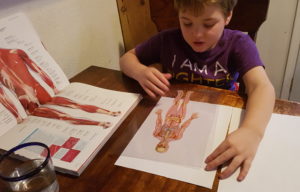 This unit has been pretty straight forward. The topic at hand isn’t particularly abstract, and the concepts aren’t complicated so we were able to move through them pretty quickly. As with the last unit, Bones, the rescue play was also very fun.
This unit has been pretty straight forward. The topic at hand isn’t particularly abstract, and the concepts aren’t complicated so we were able to move through them pretty quickly. As with the last unit, Bones, the rescue play was also very fun.
The basic goals of this unit:
- Learn about the basic structure of our muscles, how they work, and work together to control our skeleton and to create expressions.
- Learn about tendons and ligaments.
- Study and memorize the names of some of the major muscles in the body; as many as is feasible for their age, and particularly those that are the most useful to know for basic Responder Care.
- Learn some of the basic injuries that are related to our muscles; namely sprains and tears.
- Learn the basic RICE treatment for such injuries and continue learning how to use triangle bandage cravats and board splints to stabilize a muscle injury.
This is also a good time to introduce:
- Basic Triage; Classifying and Prioritizing Injuries and Issues
- Acute Stress Reactions; Sympathetic and Parasympathetic
- We renamed these ‘Speed-Up Stress Reaction’ and ‘Slow-Down Stress Reaction’
Our Reading Resources for Muscles:
(books pictured below, with more details and links on the Elementary First Responder Home Page)
- The muscle chapter of “A Trip Through the Body” by Laurie Blake
- The muscle chapter of “The Human Body Book” by Parker
- The muscle chapter of Reader Digest’s “How the Body Works”
- The Stable Injuries section of the Outward Bound book; pages 99-103
- The Acute Stress Reaction section of the Outward Bound book; pages 40-42
- SOAP study #15 in the Wilderness Medicine Workbook
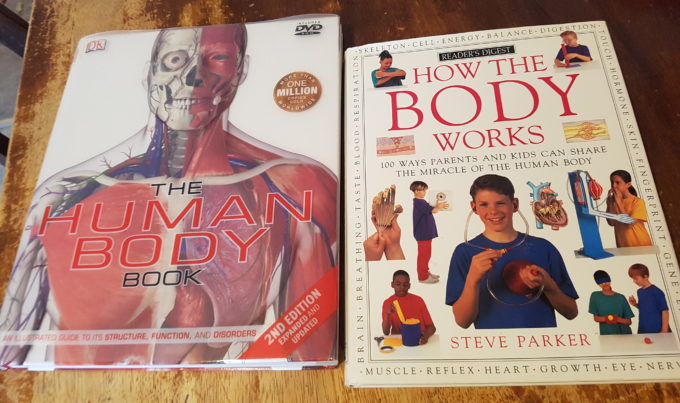
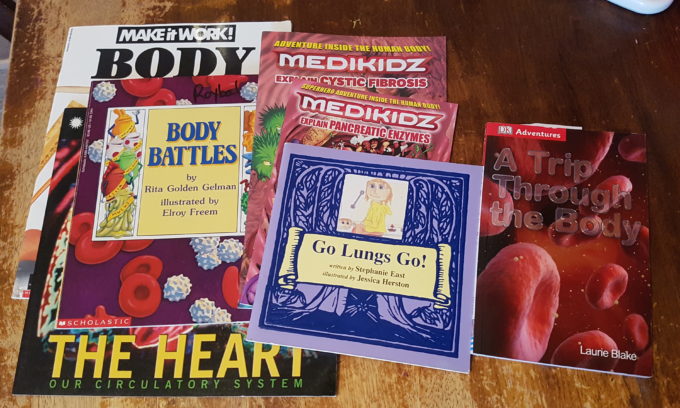
The books in the middle here are for later units, and specifically added for my son; having CF.
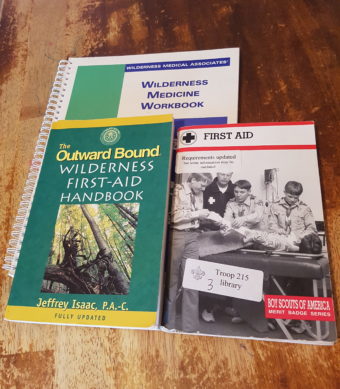
Some Hands-On Activities and Field Trip Ideas
- The Muscles model from the “MAKE it WORK! BODY” book
- Several of the easy experiments from pages 58, 60-1, 64-5 of Reader Digest’s “How the Body Works”
- Muscle Paper Craft in Scholastic “The Body Book” (pg 124)
- Use dumbbells or your own bodyweight
to explore each muscle and make them move/work.
- Visit a butcher or help butcher an animal and explore the muscle groups.
- Continue with cravate and splint ties from the first aid books and/or this great Online PDF. YouTube is also a great source.
- Practice Evacuation Carries. The Boy Scout book (and here online) has a few easy ones for one or two carriers, while this military training page is little more thorough.
- For triage practice I started by writing out a few scenarios from the Boy Scout website. We talked about each one, putting them in order of importance, a simple 1, 2, 3… then preceding with mock treatment. It’s also very easy to create your own list of patient scenarios to triage.
- Continue with Nathan’s personal First-Aid Training Book; adding a printed muscle chart, a hand drawn muscle chart, a symptom/assessment/anticipated problems/treatment page for sprains and tears, and some muscle injury drawing pages.
So how did it go for us?
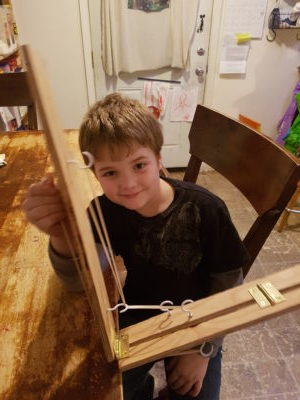
A model showing how the bicep and tricep work together to control the arm.
Having gone through the last unit we had a decent flow as to when and how to get through our planned list. The reading was pretty straight forward and the activities were mostly an expansion of the last unit’s learning, with more splint and sling practice. We did one larger project, but a lot of the ‘experiments’ (as listed above) are really simple and quick. The butcher, however, might have to be something we get to experience at a later date.
With this unit, because sprains are such a common life injury, we came across one of the most useful first-aid trainings we’ve had so far, the treatment plan of RICE – Rest, Ice, Compression, Elevation. We talked extensively about the difference between a stable and unstable injury and why it is so critical with muscular injuries to get off it! We also talked about using an anti-inflammatory such as Ibuprofen.
As for the triage ‘play,’ for now we kept it to just breaks, sprains, and minor issues. As we go through more units, learning additional anatomy and the ailments that go along with them, there will be more options for the list. We also used just a basic 1, 2, 3… ordering for care. Our family isn’t training for military service and large battlefield triage scenarios, not to mention that it’s elementary age first responders we’re talking about here, so I don’t think I’ll bother trying to teach the details of METTAGs, but we will probably learn the colors and the basic Deceased, Minor, Delayed, and Immediate categorizing at some point. When we move into the next unit, Skin, we will begin learning about our first Vital Sign, skin color and temperature, and with it we will start practicing a more official exam process. With these new bits of information Scene Size-Up will come more into focus and our basic triage skills will expand.
Having mentioned that, I really look forward to the next learning. We will be able to create some more interesting casualties, (think BLOOD!) and really build our first-aid training. Mostly it’s just nice to move the ‘Muscles’ list to the back of the stack and bring out the new one; Elementary First Responder Skills – Unit 3 – Skin!
If you like anything I’m sharing, have your own experiences, or you have a question, please drop a message! I’ll be sure to respond to you quickly!

Post a comment